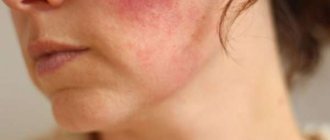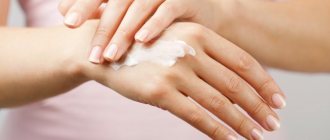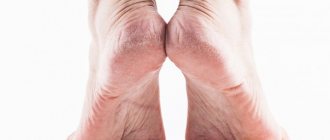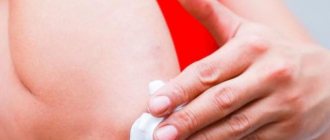When redness of the skin is periodic and is the body’s response to exposure to direct sunlight or a stressful situation, there is no reason to worry. If your face constantly burns for no apparent reason or as a result of regular exposure to provoking factors, you need to start looking for a solution to the problem. Otherwise, the development of stable complexes and serious consequences for tissues is possible. The causes of the phenomenon must be established without fail. In cases where the face turns red in response to an irritant, the provoking factor must be eliminated. Physiological pathologies will require serious treatment with mandatory intervention from a specialist.
Burning symptoms
Signs say that if your face is on fire, it means someone is talking about you. Indeed, for many centuries it was believed that the reason why the face and ears burn is just someone’s gossip. However, in reality everything is more prosaic, and these unpleasant sensations have physical or psychological reasons.
Symptoms associated with burning in the face:
sudden warming of the facial skin;- a sudden burning sensation in the facial part, which can be painful, the skin seems to be “burning” from the outside and/or from the inside;
- temporary numbness of the skin;
- feeling as if heat is “spreading” over the face;
- facial itching, sometimes manifested in other parts of the body.
Pale complexion
The main objective reason is age. In addition to facial wrinkles and age-related wrinkles, skin aging also involves a change in its shade. It turns from healthy pink to light yellow, which indicates a lack of moisture in the dermis. Its retention is entrusted to collagen fibers, which, as the body ages, begins to be produced in ever smaller quantities and ceases to fully perform its function. The skin loses moisture, dries out, and becomes vulnerable to external influences. This is facilitated by poor tissue nutrition, which occurs during less active work of the cardiovascular system. Subjective reasons are presented in several aspects at once:
- A person’s lifestyle determines the state of his body, in particular, poor nutrition, constant stress and lack of sleep lead to premature aging of the skin, which first of all becomes noticeable on the face. In addition to this, there is an environmental situation in which the oxygen content in the blood is insufficient for adequate nutrition of the tissues.
- Pale facial skin also appears with anemia and is the result of a lack of iron in the blood. This element is very important, as it acts as a conductor for oxygen. In patients of the younger age group, the presence of anemia is indicated by insufficient body weight and stunting.
- Another, no less common cause of pale skin color is vegetative-vascular dystonia. A characteristic sign of pathology will be a pronounced vascular pattern, which is especially noticeable on white skin. The clinical picture of the disease is supplemented by pressure changes, heart rhythm disturbances (arrhythmia), pain in the heart, dizziness and cyanosis of the hands.
- Diseases of the excretory system that affect the kidneys can also lead to pale skin. In such cases, the skin acquires a yellowish tint, and the mucous membranes of the oral cavity are involved in the process. The patient's condition is aggravated by weight loss, swelling and dark circles under the eyes. Pain in the abdominal area can be severe.
- Also, pale facial skin can be explained by angina pectoris, myocardial infarction, or myocarditis.
If small bruises appear on the skin and the mucous membrane of the mouth becomes covered with wounds, this may indicate the development of leukemia. At the initial stage, the disease often has signs of a common acute respiratory viral infection. The patient feels weakness, drowsiness, lethargy, which occurs against the background of elevated body temperature. However, seemingly harmless signs indicate a serious disease of the hematopoietic system, which requires the intervention of a qualified specialist.
In any case, if pale facial skin causes concern or is accompanied by other specific symptoms, you should contact a medical facility for examination.
Possible causes of a burning face
- Sunburn. The top layer of skin is irritated by ultraviolet rays, which, in addition to discomfort, also causes redness and irritation. Visiting a solarium can also cause this phenomenon.
- Rosacea, also known as rosacea. This skin disease causes vasodilation, redness and an unpleasant burning sensation, often worsening when bending down.
- Reaction to procedures. Benzoyl peroxide and salicylic acid may cause redness and burning.
- Reaction to medications. Some drugs used to treat inflammatory conditions, such as rheumatoid arthritis, can cause not only burning and redness, but also a rash.
- Cosmetic products. Frequently changing cosmetics and using chemicals can damage your skin. Some acne creams can cause inflammation and cause the skin to turn red. Hard water, soaps, creams and skin care products cause irritation. In severe cases, it can even lead to dermatitis requiring medical treatment.
- Shingles. This is an infection caused by the chickenpox virus. Even after chickenpox is cured, the virus can live in the nervous system for many years before manifesting itself as shingles. It most often appears on the body, neck and facial area in the form of a burning sensation and often blisters. Weakness and fever may be present.
- Trigeminal neuralgia. This type of neuralgia is associated with damage to the trigeminal nerve, which runs from the brain to different parts of the face. The pain and burning may be caused by a blood vessel pressing on the nerve where it meets the brain stem. Trigeminal neuralgia causes severe, recurring facial pain, usually on one side. Most common in people over 50 years of age.
- Frostbite. Occurs when the skin is exposed to extreme and/or prolonged cold. The burning sensation is accompanied by a change in the color of the skin (redness or paleness, sometimes the skin becomes yellow or gray).
- Physical trauma. Injury, scratches to the skin, or an accidental cut while shaving are common reasons why the skin begins to sting.
- Dry skin. People with dry skin are very susceptible to irritation and injury. They lack the basic oil elements that are necessary to maintain healthy facial skin. Dryness can cause cracking, leading to a burning sensation.
- Allergic reaction. Exposure to harmless substances can cause irritation resulting in a burning face.
- Dust and dirt can often disrupt the texture of the skin of the face, even without the presence of an allergy to them.
- Bacterial or viral infection. When the pores become clogged, secretion is disrupted, which leads to the accumulation of fat. This is an ideal environment for the growth and reproduction of bacteria.
- Stress, anxiety. These psychological conditions are a very common cause of facial burning. Discomfort can be felt either in a small area of the face or cover the entire area, appearing again and again in one place or in different places. The frequency and duration of burning varies. The burning sensation can be either weak or unbearably strong, be present almost constantly or disappear quickly, and the skin may turn red.
Blue-red complexion
Dilated blood vessels that turn the cheeks, nose and chin bluish-red are not a cosmetic problem, but a sign of serious illness. Even subcutaneous fatty tissue can affect the skin tone, especially when the epidermis and dermis are thinned, for example, after a serious illness: in this case, the skin acquires a characteristic yellowish tint. In young people suffering from vegetative neurosis, the face often turns scarlet with or without reason, causing considerable suffering, but even in this situation, a cosmetologist is unlikely to help: with this problem you need to contact a neurologist.
Treatment of burning sensation in the face
- For mild sunburn, the discomfort usually goes away on its own within a few days. Home remedies will help relieve redness and discomfort, for example, a paste of cucumbers pre-cooled in the refrigerator and mixed in a blender, or a mask of chilled chopped potatoes, or just cool yogurt. If the pain is very severe or blisters appear, you should immediately consult a doctor.
- Unfortunately, rosacea is a progressive disease that will continue to get worse without medical intervention. Only a dermatologist can help here.
- If you have a reaction to procedures or medications, you should stop using them and consult a physician who can help you find medications that are right for you.
- If the burning sensation is caused by cosmetic products , then try the elimination method, or stick to one product. Wash your face with boiled filtered water and use a special gentle soap for your face.
- Shingles is a good reason to seek medical help immediately.
- If you have triangular neuralgia, you should also not postpone a visit to the doctor. Surgery may be needed.
- If you have frostbite on your face , urgently find a warm room. Immerse your hands and feet in warm (under no circumstances hot!) water and wash your face with it, wrap yourself in a blanket or blanket. Avoid fire and hot lamps - they can easily burn frostbitten skin.
- In case of injury, discomfort goes away with healing. You can take painkillers.
- If your skin is dry , use creams, masks and oils to moisturize, eat more vegetables and do not forget to drink several mugs of clean, lukewarm water every day, to which you can add lemon or berry juice.
- Treat allergies according to your doctor's instructions.
- Dust and dirt can be easily removed with water or wet facial wipes.
- Treatment for the infection should be discussed with your doctor.
- Treating the physical manifestations of stress and anxiety is never easy because the problem lies in the nerves. Be sure to visit a psychotherapist who will prescribe sedatives and may suggest attending classes to control stress levels.
Yellow complexion
Problems with the liver can be judged by the yellowish-dirty and gray tint of the skin. People around you are beginning to ask the question more often: “Are you sick?” The skin not only changes color, but also appears excessively oily or dry. Often the whites of the eyes turn yellow due to increased bilirubin, and brown spots appear on the body in the form of pigmentation.
All this is complemented by irritability, apathy, and a weakened immune system. The listed signs may indicate diseases of the gallbladder and intestinal tract. Toxins entering the lymphatic system carry them to internal organs, resulting in intoxication throughout the entire body.
After a stormy night or with insomnia, our skin is in a stressful state. A yellowed face, puffy eyelids, dark circles and bags under the eyes, impaired blood flow - all this is not normal and indicates a problem with sleep. None of us wants to look bad and constantly hear: “You are sick,” so it is necessary to fight lack of sleep so as not to trigger the body’s premature decline.
Excessive consumption of sweets, flour, fried foods, as well as drinking alcoholic beverages and smoking reduce the tone of our epithelium. The skin looks inflamed, stale, its elasticity decreases, and a yellow complexion appears. The reasons that prompt a person to bad habits must be exterminated. Indeed, in addition to external unattractiveness, serious health problems arise.
Preventing a burning face
To protect your facial skin, be sure to apply SPF cream and wear a hat when the sun is scorching in the summer. Try not to change your cosmetics suddenly, do not use hard tap water to wash your face, but, as already mentioned, boil and filter it. Always make sure that a new cream or other product is suitable for your skin type.
In winter, before leaving the house, apply a rich cream to your face. In severe frost, protect the lower part of your face with a scarf and collar. Keep your home clean by dusting every day. To quickly get rid of redness, use creams with shea butter.
Having one or two episodes of a burning face does not mean that you have a serious illness. Maybe you are too stressed at work. In addition to consulting with a psychotherapist, practice breathing exercises, yoga, meditation, and give yourself a good rest on weekends and during vacations.
Do not skip washing your face in the morning and evening, always remove makeup at night, and wash your face after returning from the street. It is undesirable to use cloth towels - bacteria accumulate in them; disposable paper towels are preferable.
Diagnostics
- Survey of patients. Collection of complaints, information about lifestyle, chronic pathologies, injuries, operations.
- Inspection. The places of redness are carefully studied, their size and nature are determined.
- Laboratory tests (blood, urine) for inflammatory, biochemical abnormalities, antigens or antibodies.
- Skin swabs to identify the causative agent of the disease.
- Instrumental techniques (ultrasound, MRI, CT, X-ray, etc.) to study abnormalities in the functioning of internal organs.
- Allergy tests.
Further facial skin care
The facial care program is developed individually for each person. To make it most effective, all the characteristics of the body are taken into account. Cosmetologists divide skin into four types: normal, oily, dry, combination. Based on this, cosmetic products are selected.
Why do eyelashes fall out?
The easiest way is to create a normal skin care program. Its owners are guided by general recommendations. When washing, use products without antibacterial agents and alcohol. Scrubs are used once a week. Choose cosmetics with extracts of aloe, tea tree, chamomile and calendula.
Note! Oily skin types require special care. It is important not to provoke an increase in the activity of the sebaceous glands and not to allow the upper layer of the epidermis to dry out. The skin is well cleansed, treated with a bactericidal agent and moisturized.
Dry skin requires delicate care. Do not wash with products with a lot of foam, so as not to wash away lipids from the skin. The water for washing should be warm. Masks of cream and gel texture are used. It is important to monitor the level of air humidity and include fish rich in fatty acids in the menu.
A person with combination skin type has its own nuances. Peeling is done twice a week. Different products are used for different areas of the skin.
Important! Improper skin care may not only not solve the problem, but even worsen it.
In any case, you need to cleanse the epidermis of the face, tone and nourish it. Although the means will be different for everyone, homemade masks are always useful. They soothe irritated skin, normalize blood circulation and fight redness. The masks are kept on the face for half an hour and done 2-3 times a week.
Oatmeal mask
Two tablespoons of flakes are crushed and poured with 6 tablespoons of hot water. Leave for 15 minutes and mix well.
Oatmeal face mask
Curd mask with kefir
Two tablespoons of full-fat cottage cheese are diluted with kefir until creamy.
Carrot mask
Grate the carrots and immediately apply to your face. You can squeeze juice out of carrots and mix it with cottage cheese.
Cucumber mask
The cucumber is peeled, grated and applied to the face. It is effective to mix cucumber and zucchini pulp together.
Cucumber mask to moisturize skin
Potato mask
Peel fresh or boiled potatoes, grate them and mix with olive oil.
Egg mask
Beat the egg and mix with 2 tablespoons of rice flour.
Banana mask
Chop the banana and beat until pureed. Mix 2 tablespoons of the mixture with 1 teaspoon of cream and 2 tablespoons of pureed cottage cheese.
Masks with fabric
Fold the gauze in several layers, dip in green tea, herbal decoction, cabbage or aloe juice and apply to the face.
If you take care of your face correctly and regularly, after a month the redness will disappear and your face will stop burning.
Fabric face mask
Ways to get rid of redness and burning of the face
How to properly cleanse your face every day step by step
When the face is burning and red, the causes are eliminated with drastic measures and simple methods.
The photocoagulation procedure will help get rid of red spots on the face
For quick treatment, go to a beauty salon and undergo procedures: photocoagulation, galvanization or ultrasound cleaning.
At home, use natural means at hand.
There are several techniques for self-medication:
- First of all, they bring the psychological state back to normal, stop being nervous and worried, and avoid nervous overstrain;
- The cause of the problem may be low self-esteem, in which case they undergo a course of treatment with a psychotherapist;
- When going outside, use special protective creams against hot and cold temperatures;
- Bring your diet back to normal; food should contain more fruits and vegetables. You need to refuse to eat fatty, salty, spicy foods;
- Alcohol and smoking are prohibited;
- It is worth taking a multivitamin complex and getting tested for allergies.
You should not use all of the above remedies together for treatment. You can decide why your face is red and burning, what to do, by determining the cause of the situation.
Vitamins for facial skin
A quick way to mask a face that has begun to become red and get rid of psychological discomfort is to start using homemade face masks. By spending one evening a week on them, they achieve a positive result.
Gray complexion
There are several main reasons for changes in complexion:
- natural aging process;
- heredity;
- unhealthy lifestyle, drinking alcohol, smoking;
- lack of sleep;
- poor nutrition;
- acute and chronic diseases.
If this problem occurs, you should consult a doctor, as this may indicate a serious illness. A gray face, as a rule, indicates problems of the gastrointestinal tract, and with pancreatic disease, the face becomes sallow. Also, complexion may change due to long-term use of certain antibiotics.
In addition, smoking and alcohol abuse are often the cause of a gray and sallow complexion. Poor nutrition and a sedentary lifestyle negatively affect the condition and color of the skin. Regardless of the cause, when your complexion changes, you need to take steps to restore your face to a healthy, radiant appearance.











